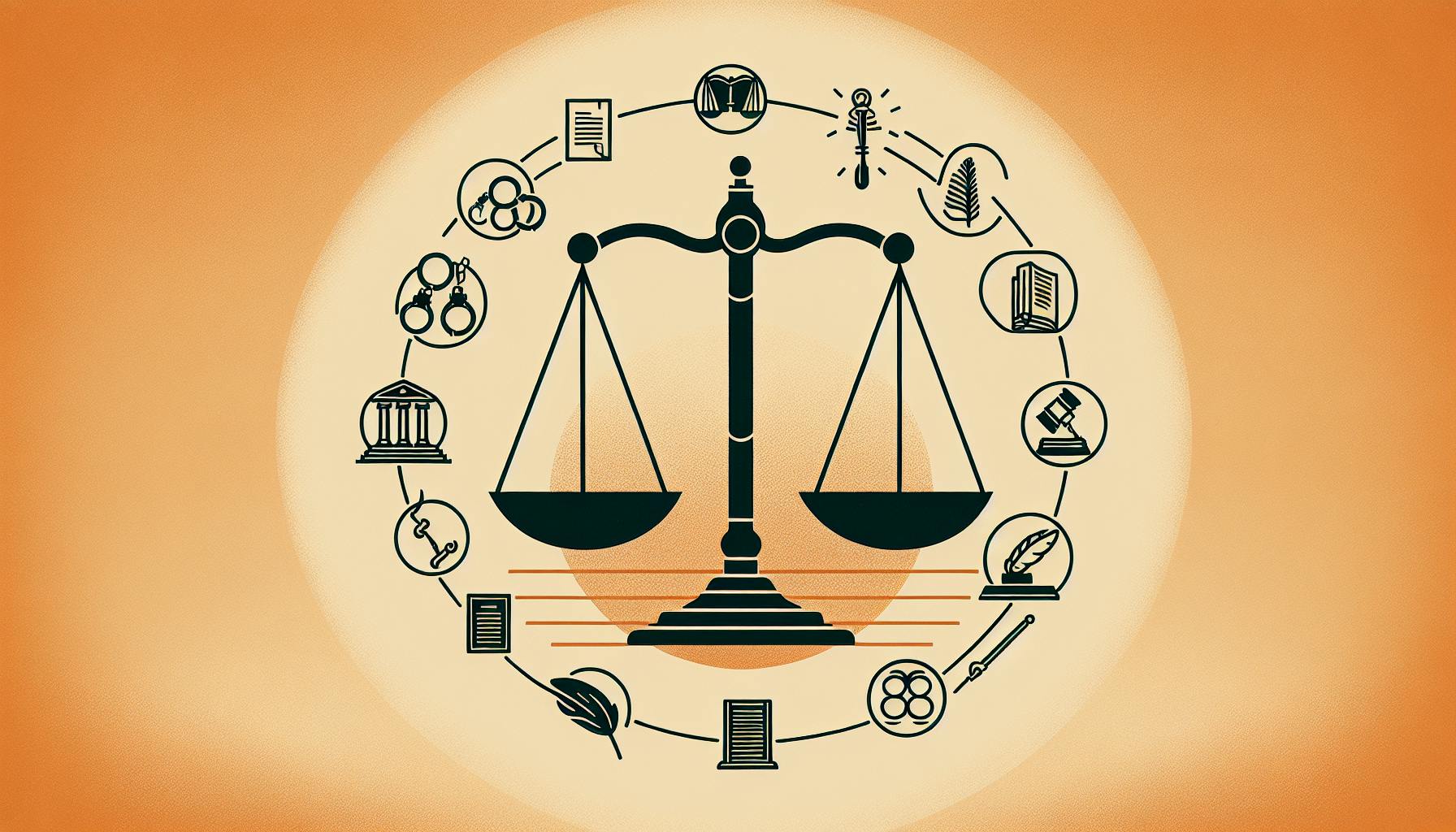Most will agree that understanding complex historical events requires examining multiple perspectives.
By exploring the story of Sacco and Vanzetti, we can gain insight into the social climate of 1920s America and the complex interplay between fear, prejudice and justice that shaped their controversial trial.
This article will analyze the background of the case, the anarchist views held by the defendants, the reasons they provoked fear in the mainstream public, and the debates their trial sparked regarding fairness and due process that still resonate today.
The Case of Sacco & Vanzetti
Anarchism and Fear in the Roaring Twenties
The 1920s in America was a time of economic prosperity and cultural change known as the Roaring Twenties. However, it was also a time of social unrest and fear due to the rise of radical political movements like anarchism.
Anarchists advocated the abolition of government and hierarchy in favor of voluntary cooperation. While most anarchists were peaceful, some promoted violence to achieve their goals. A series of bombings and assassination attempts by anarchists in 1919-1920 fueled public anxiety.
The anarchist movement was seen as a threat to American values and way of life. This climate of fear set the stage for the controversial trial of Nicola Sacco and Bartolomeo Vanzetti, two Italian immigrant anarchists accused of murder.
The Crime Scene: A Catalyst for Controversy
On April 15, 1920, a robbery occurred at a shoe factory in South Braintree, Massachusetts, resulting in the deaths of a paymaster and guard. That same evening, police arrested Sacco and Vanzetti, who were carrying guns at the time.
The crime scene evidence was mishandled by police, with confusion over which bullets came from which gun. This created doubts around whether Sacco and Vanzetti were truly guilty.
Their anarchist political leanings and immigrant status also bred suspicion that they were arrested based on identity rather than hard evidence. The controversial arrests catalyzed a major trial.
The Red Scare of 1919–1920: Contextualizing the Case
The Sacco and Vanzetti case emerged alongside the First Red Scare of 1919-1920 in America. The Red Scare was a period of intense fear and paranoia around radical leftists and immigrants.
Anarchist attacks and labor unrest sparked government raids targeting suspected radicals. Thousands of immigrants were deported without due process. Anti-immigrant, anti-leftist sentiment was widespread.
This sociopolitical climate clearly impacted the trial, as Sacco and Vanzetti's anarchist views were used against them. The case became a symbol of injustice toward immigrants and radical political minorities.
How were Sacco and Vanzetti anarchists?
Sacco and Vanzetti were followers of anarchist Luigi Galleani and rejected both the state and private property. Like thousands of other manual laborers in the early 20th century, they subscribed to Galleani's particular strain of ""anarchist communism"" which advocated the violent overthrow of government.
As anarchist-communists, Sacco and Vanzetti fundamentally opposed:
- The state and governmental authority
- Private ownership of property and capital
- Hierarchical economic and social relations
Instead, they believed in:
- Worker-controlled industry
- Collective ownership of property and the means of production
- A classless society without ranks or privilege
Sacco and Vanzetti saw anarchism as a way to liberate the working classes from economic inequality and the tyranny of the powerful. They gravitated towards Galleani's urgent calls for direct action and confrontation with the establishment.
Ultimately, Sacco and Vanzetti's embrace of anarchist ideology and revolutionary rhetoric put them under suspicion and led to their prosecution during the First Red Scare of 1919-1920. Their case became a flashpoint for debates over immigration, radicalism, and justice in America.
How were Sacco and Vanzetti linked to the fear generated by the Red Scare and anarchism?
Sacco and Vanzetti were Italian immigrants who embodied some of the primary targets of the Red Scare in the aftermath of World War I. As followers of a radical political ideology, anarchism, they came to symbolize the perceived threats that foreigners and radical beliefs posed to American institutions and values.
Specifically, Sacco and Vanzetti:
- Were immigrants, which fueled nativist fears about foreign influences
- Espoused anarchist political beliefs, which threatened the capitalist American system
- Avoided the draft during WWI, raising questions about their loyalty
- Had firearms and anarchist literature when arrested, linking them to violence and radicalism
In the tense sociopolitical climate of the 1920s, these factors tied Sacco and Vanzetti to broader fears about immigration, political radicalism, and social unrest. Their case became a flashpoint for deeper national anxieties regarding these perceived threats to the American way of life.
Though questions remain about their guilt or innocence, Sacco and Vanzetti's status as immigrant anarchists made them targets of both the Red Scare hysteria and the backlash against perceived radicals in 1920s America. Their case symbolized broader societal fears regarding immigration and political beliefs deemed dangerous by many Americans at the time.
Why were Sacco and Vanzetti feared?
Anti-immigrant and anti-radical sentiments in the 1920s led the police to focus on local anarchists like Sacco and Vanzetti. As followers of Luigi Galleani, a radical Italian anarchist who had instigated bombings against public officials after World War I, Sacco and Vanzetti were viewed with suspicion and fear by authorities.
This climate of fear stemmed from larger societal tensions - the Red Scare and restrictive immigration policies bred distrust of immigrants, radicals, and labor organizers. Sacco and Vanzetti's anarchist political leanings, immigrant backgrounds, and evasive behavior when questioned fed into these fears.
Authorities likely saw them as embodiments of radical foreign influences and threats to the American way of life. Their prosecution and execution can be seen as a warning against dissidence. The case revealed deeper societal divisions over immigration, radicalism, and justice that still resonate today.
sbb-itb-e93bf99
sbb-itb-e93bf99
sbb-itb-e93bf99
sbb-itb-e93bf99
What impact did Sacco and Vanzetti have in the 1920s?
The Sacco and Vanzetti case brought intense scrutiny on the American justice system in the 1920s. As noted by critic Edmund Wilson, it "revealed the whole anatomy of American life" and "raised almost every fundamental question of our political and social system."
Some of the key impacts of the case include:
-
Highlighted tensions over immigration and anarchism: The case fueled public fears over radical immigrants, anarchists, and labor activism in the post-WWI period. It became a symbol of the "Red Scare" sentiment against immigrants.
-
Exposed potential miscarriages of justice: Many felt Sacco and Vanzetti were convicted unfairly due to their immigrant status and radical views rather than hard evidence. This raised concerns over the objectivity of the justice system.
-
Sparked protests and activism: The case triggered mass protests, with over 10,000 people marching in Boston at one point. It activated labor unions, immigrant communities, and leftist groups.
-
Put the death penalty into question: The executions increased opposition to the death penalty. Over the long-term, support for capital punishment declined.
-
Influenced later activists: Figures like Martin Luther King Jr. and Nelson Mandela pointed to the case as an inspiration for their human rights campaigns. It encouraged later generations to continue the fight against injustice.
So in many ways, the Sacco and Vanzetti case shaped views on immigration, justice, protest movements, and the death penalty in impactful and long-lasting ways during the 1920s. It exposed some uncomfortable truths about American society that sparked calls for reform.
The Massachusetts Supreme Judicial Court and the Trial
Sacco and Vanzetti's trial in 1921 took place in a charged social climate influenced by anti-immigrant sentiment and the Red Scare. They faced an uphill legal battle as Italian immigrant anarchists.
The Setting: Massachusetts in the 1920s
Massachusetts in the 1920s was marked by social tensions stemming from rapid industrialization, immigration, and the aftermath of World War I. Anarchist bombings aimed at government officials had stirred fears of radicalism, leading to the Red Scare and restrictive immigration policies targeting Southern and Eastern Europeans.
Sacco and Vanzetti stood trial in this climate of suspicion toward immigrant radicals. Their status as Italian immigrants and self-proclaimed anarchists already cast doubt on them in the eyes of many. The setting was far from an impartial one for the defendants.
The Evidence: Scrutinizing the Prosecution's Case
The prosecution's case against Sacco and Vanzetti consisted of circumstantial evidence open to interpretation.
Key evidence included:
- Eyewitness testimony placing Sacco and Vanzetti at the crime scene
- Similarities between Sacco's gun and the murder weapon
- The defendants' behavior when arrested, including lies about their past activities
The defense argued this evidence was far from conclusive. The prosecution's narrative did not account for all the facts.
Cross-examination of the Defendants: Anarchism on the Stand
During cross-examination, Sacco and Vanzetti's anarchist political leanings were used against them. The prosecution drew attention to their evasive answers about past radical activities.
References to the defendants as "Bolsheviki" and the climate of fear toward immigrant anarchists likely prejudiced the jury against them. Their anarchist views put them at a disadvantage regardless of the facts of the case.
Judge Thayer's Charge to the Jury: Bias on the Bench?
In his instructions to the jury, Judge Webster Thayer emphasized the defendants' untruthful statements to police as indications of guilt. He dismissed evidence that did not align with the prosecution's version of events.
Thayer's charge has been criticized as biased. Ultimately the jury found Sacco and Vanzetti guilty of murder, setting the stage for their controversial execution.
The Fight for Justice: Appeals & Death Sentence
Over the next six years, appeals raised doubts about the trial's fairness but failed to overturn the verdict, and Sacco and Vanzetti were executed in 1927.
Motions for a New Trial: The Legal Battle Intensifies
After the guilty verdict, the defense team filed multiple motions arguing that Sacco and Vanzetti deserved a new trial. They pointed to Judge Thayer's clear bias, citing inflammatory statements he made outside the courtroom. Thayer referred to the defendants as "anarchist bastards" and claimed the trial was just a formality before their execution.
The defense also submitted new forensic evidence about the bullets and guns used in the crime. Firearms experts cast doubt on the prosecution's claims matching Sacco's gun to the crime scene bullets. All motions were denied by Thayer, revealing a rigged justice system.
The Madeiros Confession: A Twist in the Case
In 1926, Celestino Madeiros, a convicted murderer awaiting execution, confessed to committing the Braintree robbery and killings. His story matched key details about the crime unknown to the public. The Sacco-Vanzetti Defense Committee tried to introduce the confession as new evidence before the Massachusetts Supreme Judicial Court.
However, the Court ruled that Madeiros's confession while facing the electric chair carried little weight. They believed he made the claim only to delay his own execution. This shocking disregard of potentially exonerating evidence revealed the courts unwillingness to admit their mistakes.
Felix Frankfurter's Critique: A Scholarly Intervention
In 1927, Harvard law professor Felix Frankfurter published a detailed analysis of the case in The Atlantic magazine. He scrutinized Judge Thayer's blatant mishandling of courtroom proceedings and confrontational behavior toward the defendants.
Frankfurter argued "no English-speaking community in the world...would have judged them guilty." His critique helped shift liberal opinion to support Sacco and Vanzetti's innocence. But the courts stubbornly upheld the original verdict, ignoring Frankfurter's reasoned legal arguments.
The Lowell Committee: A Review of Justice
In response to the growing outcry, Massachusetts Governor Fuller appointed the Lowell Committee in 1927 to review the case. After weeks of investigation, the Committee upheld Judge Thayer's conduct and the guilty verdict. They claimed no substantial new evidence proved Sacco and Vanzetti's innocence.
Critics condemned the Committee as biased toward the establishment. They dismissed evidence of a rigged trial and seemed unwilling to admit a miscarriage of justice had occurred. With all legal options exhausted, Sacco and Vanzetti were executed later that year.
A National and International Sensation: The Sacco and Vanzetti Case
The Sacco and Vanzetti case was controversial from the start, drawing national and international attention. As the case unfolded over several years, it came to symbolize broader issues around justice, immigration, and political repression in America during the 1920s.
The Executions & Funeral: An End and a Beginning
On August 23, 1927, Sacco and Vanzetti were executed in the electric chair, despite years of appeals and protests. They both proclaimed their innocence one final time. Huge crowds gathered outside the prison in a massive show of support. Their funeral on August 28 brought over 200,000 mourners in Boston. The executions marked the end of a long legal drama, but also sparked the beginning of the case's enduring legacy.
Proclamation and Public Reaction: The Aftermath of a Legal Drama
In 1977, Massachusetts Governor Michael Dukakis issued a proclamation apologizing to Sacco and Vanzetti for their unfair trial and unjust executions. Many still debate their guilt or innocence, but most agree they did not receive justice. The case fueled lasting mistrust of the legal system, especially among immigrant communities who felt targeted. It also led to reflections on ensuring fair trials for all.
Restrictive Immigration Acts: The Case's Influence on Policy
In the wake of the Sacco and Vanzetti case, the U.S. government passed more restrictive immigration policies, fueled by anti-immigrant sentiment. The National Origins Act of 1924 set strict quotas substantially reducing immigration. These policies were influenced by xenophobic fears of immigrants, radicals, and anarchists, as epitomized by the Sacco and Vanzetti case.
The Legacy of Fear and Anarchism in the Roaring Twenties
The Red Scare following WWI, intensified by the Sacco and Vanzetti case, demonstrated how fear shaped America during the 1920s. Though Sacco and Vanzetti were not violent, the climate of fear unfairly linked immigrants to radicalism. The case revealed how easily civil rights could be violated when fear overshadowed justice. Its legacy serves as a vital reminder of the dangers of political repression.
Conclusion: Reflecting on Justice and Prejudice
The Sacco and Vanzetti case raised difficult questions about justice, prejudice, and the treatment of immigrants that still resonate today. Their controversial trial and executions came to symbolize the climate of fear and intolerance towards radicals and foreigners in 1920s America.
As we reflect on the case, several key questions emerge:
-
Were Sacco and Vanzetti given a fair trial, or was the deck stacked against them from the start due to anti-immigrant sentiment? The judge and prosecution certainly seemed biased against them as Italian anarchist immigrants.
-
Should controversial political beliefs or immigrant status determine one's right to justice? Their radical views seemed to overshadow the actual evidence in their highly politicized case.
-
How can we uphold principles of universal justice and tolerance for diversity in times of societal fear and unrest? The Red Scare climate tested America's commitment to civil liberties.
The enduring legacy of the case reminds us to remain vigilant against prejudice. It highlights the need to ensure equal treatment under the law for all defendants, regardless of background, beliefs, or nationality. Maintaining an open, just legal system protects the innocent and helps calm societal tensions.
While some questions around Sacco and Vanzetti’s guilt or innocence remain, the controversial case continues prompt vital conversations about justice in America. Their executions were a tragedy we must not repeat.
The Enduring Questions of the Sacco and Vanzetti Case
The Sacco and Vanzetti case left several questions still debated today:
-
Were they rightly convicted based on solid evidence, or unfairly railroaded by a biased system? The evidence remains inconclusive to many.
-
If they were innocent, can such a miscarriage of justice be prevented in the future? It spotlights flaws in the legal system.
-
How much did contemporary biases against their immigrant status and radical views impact the verdict? The case reveals ethnic and political tensions in 1920s America.
Their controversial convictions and executions raised doubts about prejudice in the justice system that still concern us today. The case continues to symbolize broader issues around tolerance and civil rights that remain relevant nearly a century later.


